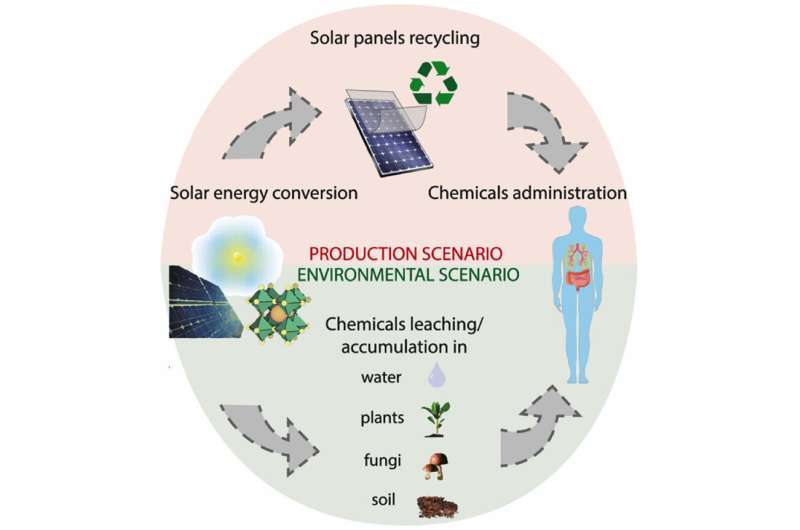This article has been reviewed according to Science X's editorial process and policies. Editors have highlighted the following attributes while ensuring the content's credibility:
fact-checked
peer-reviewed publication
trusted source
proofread
Study suggests lead from innovative solar cells is not as toxic as feared

Scientists from Skoltech and other research centers have systematically studied the toxicity of materials used in perovskite solar cells. They conclude that, once the remaining technological hurdles are overcome, mass production of this potentially cheap and efficient alternative to silicon-based photovoltaics should not cause any significant environmental risks and health hazards. Reported in Solar Energy Materials and Solar Cells, the study draws attention to perovskite components other than lead, suggesting that metal's toxicity, by comparison, could be overestimated.
Perovskite solar cells are a highly promising photovoltaic technology, which could provide a sustainable alternative to fossil fuels. With a top recorded power conversion efficiency of 25.7%, perovskite solar cells have almost matched the performance of their crystalline silicon-based counterparts, which hold the current record. The new technology's potential to reach even higher efficiencies, and possibly very low production costs as well, prompts research that seeks to address its remaining shortcomings.
Three problems are hampering the widespread adoption of perovskite-based photovoltaics. As of now, the technology is hard to scale up because of the difficulty of depositing perovskite—the light-harvesting material—in an even layer spanning a large area. Also, perovskites are unstable and need to be protected with transparent polymers. Once this protection deteriorates, perovskite decomposes into substances that may pose environmental and human health risks.
The latter issue—the materials' toxicity—was at the focus of an investigation by Skoltech Ph.D. student Margarita Chetyrkina and her co-authors from the Research Center for Medical Genetics and the Federal Research Center of Problems of Chemical Physics and Medicinal Chemistry of RAS. Their study featured experiments both on human cell cultures (in vitro) and in mice (in vivo).
The first phase of the experiment involved connective tissue cells called fibroblasts and glial cells of the nervous system. "We considered to what extent the addition of each of the six perovskite-related substances to a cell culture affected its growth: what proportion of the cells died over the course of three days," Chetyrkina said. "Prior studies did not supply data that would enable direct comparisons between these chemicals in terms of their toxicity."
One can see a perovskite as being composed of two principal constituents: lead, tin, or bismuth iodide on the one hand and methylammonium, formamidinium, or cesium iodide on the other. In cell tests, bismuth iodide showed the least toxicity in the first group. Cesium and formamidinium iodides had less of a detrimental effect on cells than methylammonium iodide.
"When we continued the tests on mice, this time focusing on three compounds—methylammonium, formamidinium, and lead iodides—something unexpected happened," Chetyrkina said. "The toxicity of lead is well-established, but it turned out that in a living organism the comparatively low solubility of lead iodide made that substance less biologically available. Methylammonium proved to be the most toxic of the three, in stark contrast to the results of experiments on cells."
In other words, it sure is bad if you happen to ingest a hazardous substance, but the crucial factor is how much of that substance ends up in your bloodstream, and solubility affects that a lot. The experiment on mice shows that, if bioavailability is duly accounted for, all of a sudden the much-maligned lead might pose fewer health risks than the organic components of perovskite solar cells, particularly methylammonium iodide.
The authors of the study also argue that even in a hypothetical world where perovskite solar cells have fully phased out their silicon-based counterparts, the share of the photovoltaic industry in the global consumption of lead will be a fairly modest 4%—equivalent to how much lead goes into beauty products.
"We're seeing an encouraging trend in perovskite solar cell development. And although there are obstacles that make widespread application of this exciting technology not feasible right now, it seems this might change fairly soon," Chetyrkina added.
More information: Margarita R. Chetyrkina et al, Lead, tin, bismuth or organics: Assessment of potential environmental and human health hazards originating from mature perovskite PV technology, Solar Energy Materials and Solar Cells (2023). DOI: 10.1016/j.solmat.2022.112177
Journal information: Solar Energy Materials and Solar Cells
Provided by Skolkovo Institute of Science and Technology





















